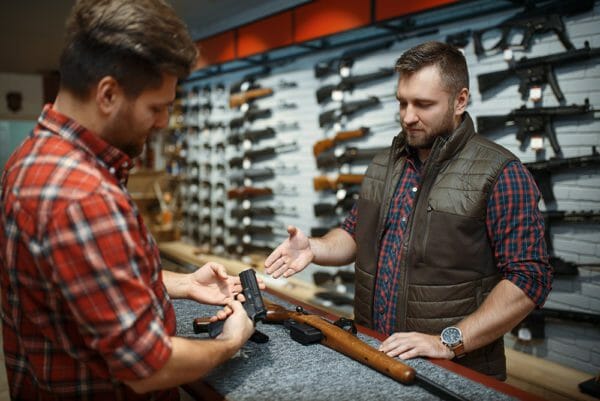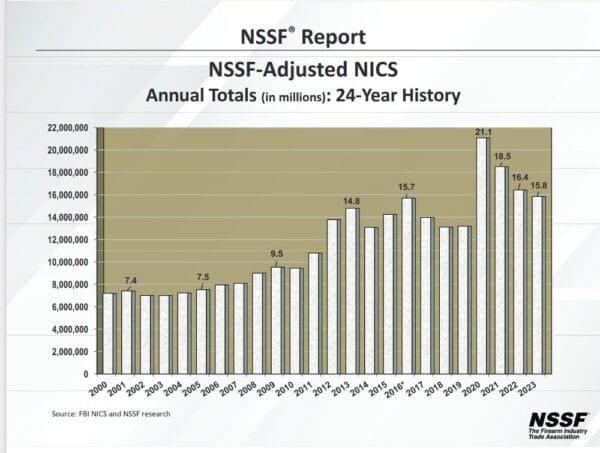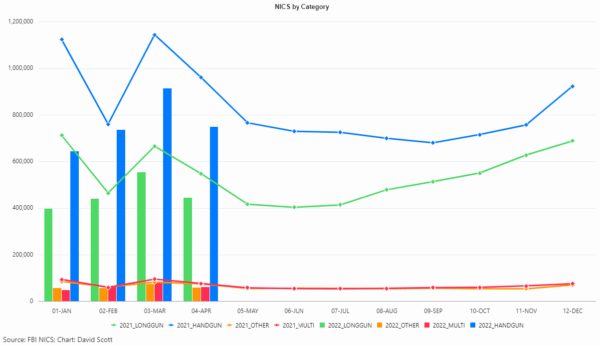
According to FBI records from the National Instant Background Check System (NICS), April 2024 was the fifth highest on record for gun sales and background checks for that month. The month follows a pattern which has developed over the last five years. A gradual drop in sales and background checks from the record-level highs of 2020 and 2021 has become consistent.
Even with the drop in sales, the numbers are still at or above the “new normal” established during President Obama’s second term. President Obama was given the honorary title of “the best gun salesman ever.” In the NSSF chart for gun sales by year, you can easily compare adjusted annual sales from before 2008 and after 2008. With President Obama’s election in 2008, annual gun sales bumped to record levels.


By 2012, gun sales were about 50% higher than sales pre-Obama. With the revolutionary election of President Trump and his phenomenal success in the Oval Office, gun sales dropped but never retreated to pre-Obama levels.
The deeply flawed election of 2020 set off more records, with gun sales roughly three times higher than they were only 15 years earlier. In 2005, NSSF showed adjusted gun sales of 7.5 million for the year. In 2020, 21.1 million gun sales, or 2.8 times the sales of 2005. Population in the USA increased from 296 million to 331 million, about 12% in the same time period. Gun sales increased from .025 per person in 2005 to .064 per person when comparing 2005 to 2020. NSSF reports gun sales have remained over one million per month for the last 57 months.
With a sluggish economy and rampant inflation, the market for more firearms has slowed. It is likely that 2024 will show gun sales similar to those in the second term of President Obama. Those levels, of about 14 million per year, appear to be the new normal. Because manufacturers have ramped up production to respond to record demand, prices have been falling for some of the most popular firearms, such as the ubiquitous and common AR15-style rifles. Accounting for inflation, the price of serviceable AR15-style semi-automatic rifles is the lowest ever seen.
As seen in the chart below, handguns are the most commonly sold firearms in today’s market.

In 1965, Colt advertised the AR15 semi-automatic rifle at $189.50, which would be $1885.50 in today’s dollars. Colt’s patent ran out in 1977, and today, dozens, if not hundreds, of companies manufacture various versions of AR15-style rifles. A fully functional rifle can often be acquired today for about $400, or 21% of what a functionally similar rifle cost when Colt introduced them for sale to the civilian market in 1965. Ammunition is readily available at this time. Prices for ammunition are reasonable, given inflation. Modern ammunition has a shelf life measured in several decades if stored and kept dry in temperatures common to most households.
Given the durability of firearms and ammunition, market saturation becomes possible. Innovation, such as the recent offering of small, handy, accurate, and reliable .22 semi-automatic handguns with magazine capacities from 15-to 20 rounds, can overcome market saturation. The demand for suppressors and suppressor-ready firearms continues at a high level. The Biden administration is pushing for multiple restrictions on the firearms market and is being stoutly opposed in the courts.
If another political revolution occurs in November, restrictions may be reduced, but a return to a more rational political sphere may reduce demand.
About Dean Weingarten:
Dean Weingarten has been a peace officer, a military officer, was on the University of Wisconsin Pistol Team for four years, and was first certified to teach firearms safety in 1973. He taught the Arizona concealed carry course for fifteen years until the goal of Constitutional Carry was attained. He has degrees in meteorology and mining engineering, and retired from the Department of Defense after a 30 year career in Army Research, Development, Testing, and Evaluation.

from https://ift.tt/eN1nmFy
via IFTTT

No comments:
Post a Comment